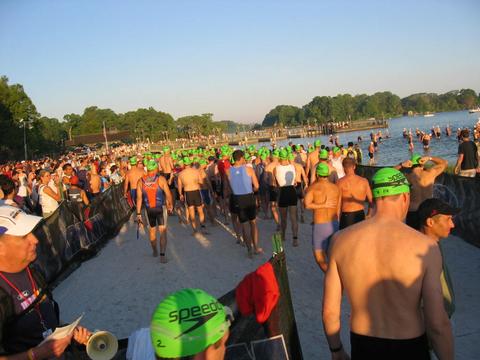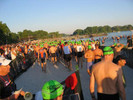How Athletes Beat The Heat in Hot and Humid Conditions
Posted by Matt Russ on 26th Jun 2025
 Unfortunately, heat is not something you can “beat,” but you can optimize your performance by preparing for and acclimating to it. It is important to understand your body’s individual physiological response to a hot and/or humid environment, and how much energy it must expend to cool itself. You may be surprised that most of the chemical energy used for muscular contraction is lost as heat-- up to 90% at high intensities! And we must maintain core temperature in a range of 35-42°C during exercise or our bodies will shut down. The worst conditions an athlete can face are hot, humid, sunny, and windless, in which exercise or competition is occurring at a high rate of intensity. The "best" athlete does not always win in these conditions; it may be the most heat tolerant!
Unfortunately, heat is not something you can “beat,” but you can optimize your performance by preparing for and acclimating to it. It is important to understand your body’s individual physiological response to a hot and/or humid environment, and how much energy it must expend to cool itself. You may be surprised that most of the chemical energy used for muscular contraction is lost as heat-- up to 90% at high intensities! And we must maintain core temperature in a range of 35-42°C during exercise or our bodies will shut down. The worst conditions an athlete can face are hot, humid, sunny, and windless, in which exercise or competition is occurring at a high rate of intensity. The "best" athlete does not always win in these conditions; it may be the most heat tolerant!
Lance Armstrong brought an interesting device into the media spotlight during one of his Tours. The Corecontrol glove is a relatively simple tool used to help cool the body down. The athlete places their hand in the glove and a slight vacuum is applied while the hand is cooled. Why the hand? The body loses heat rapidly from certain areas of the body where there is more blood flow, such as the face, feet, and hands. Why would this make a difference? As noted, our bodies expend enormous amounts of energy to maintain core temperatures, and in an event such as a time trial, in which the podium is gained by fractions of a second, even a slight cooling effect will make a difference. Obviously cooling, or in this case pre-cooling the body is of great importance for optimal athletic performance and the pros look for every advantage they can find.
The body cools itself through a variety of means. Heat is conducted from the muscles to the skin surface and transferred to the surrounding air by convection. Heat is also drawn to the surface of the body via sweat, which then evaporates on the skin surface causing heat loss. The respiration process dispels heat as water vapor, as does excretion of body wastes. If the environment is colder than the skin temperature, it will absorb body heat through radiation. However, if exercise is undertaken in an environment warmer than the skin temperature the body absorbs heat from the environment and can not lose heat through convection/radiation. The sweat/evaporation process becomes the primary means of heat loss during exercise in hot and humid conditions.
Not everyone will react to heat and humidity the same. In fact, there is a wide variance in efficiency between athletes exercising in the same conditions, and individual heat/humidity tolerance should absolutely factor into race planning strategy. Smaller athletes have a distinct advantage and may be able to maintain rates of adequate heat loss as larger athletes shut down. Smaller athletes have greater surface area to body mass, and comparatively, larger athletes will have to sweat more and utilize more energy in order to produce the same heat loss at the same running speed. Body fat percentage is another factor that affects heat dissipation. Body fat is an insulator and while it is advantageous for cold weather training, it retains heat in warmer conditions. Beginner or de-conditioned athletes will have less heat tolerance and greater sweat rates compared to highly conditioned athletes, and are at greater risk for heat illness/stroke. Slower athletes will have less air flow over the body further reducing heat loss. Finally, it requires one to two weeks to acclimate fully to a new environment, and once acclimated, an athlete will have a considerable advantage over another that is not. An acclimated athlete will have a lower heart rate, salt content of sweat, core temperature, and sweat rate; however, athletes that race in their normal training environment may still have an (home court) advantage over those recently acclimated.
Temperature is but one factor that influences cooling effect. Wind speed, humidity, and the radiant heat absorbed from the environment also affect heat dissipation. For instance, an athlete will absorb more radiant heat on an asphalt road in the sun versus a shady trail in the same heat/humidity/wind. Under very humid conditions, sweat rolls off the body at certain points with less cooling effect, whereas wind speed increases the convective heat loss. It is important to recognize and attempt to prepare for all of the environmental factors you will face. This may mean manipulating your local training environment with extra layers or with reduced air flow over the skin (indoors), however great care must be taken and acclimation should be a gradual process. Excessive sweating should never be a performance goal, and you should not exceed the projected conditions you will be racing in.
Clothing selection is another important factor in heat loss. Newer micro fiber clothing creates a greater evaporative surface by “spreading out” sweat and may be more effective than training without a shirt. Light weight, breathable fabrics are most desirable for dissipating heat and light colors reflect heat whereas dark colors absorb it. A point of greater heat dissipation is the scalp and neck. Headgear will retard heat loss in these areas. A visor will be preferable to a hat in hot conditions.
For triathletes, cooling the body on the run should be of the greatest concern, however, a long slow climb on the bike may produce similar conditions. Interventions such as cold sponges, icing, and of course ingesting cold fluids will help cool the body to a modest extent. Muscle heat generation increases with exercise intensity and is probably why athletes overheat close to the finish with their final kick.
It is obvious that fluid and electrolyte ingestion is tantamount, however consumption is highly individualized. Heart rate increases with a drop in blood volume as the body must work harder to circulate a more limited amount of blood to cool the body. For some athletes, ingesting enough fluid to offset loss is an impossibility. Electrolytes are the gate keepers for fluid movement within the body and without adequate intake the gates lock up. Sodium, Chloride, Potassium, and Magnesium are the most crucial electrolytes to replace with the greatest emphasis on Sodium/Chloride. It is important to note that hypernatremia is rare whereas hyponatremia (low blood sodium) is of far greater concern, especially for beginner athletes participating in ultra distance events.
Understanding that you may have a tactical advantage/disadvantage in certain climactic conditions is a very important step to planning your race season. Once you have chosen your races, compare your local climate with the conditions in which you will be racing. If arriving a few weeks early is impractical, interventions such as exercising in the hottest part of the day may help prepare the body for what it will face on race day. Review the course, especially the run. Is it windy, shady, or open asphalt? Choose your clothing carefully and have a detailed hydration/electrolyte supplementation strategy planned out according to your individual tolerances. Heat may be the toughest competitor you face on race day, but with a bit of planning you can greatly mitigate the effects.
Matt Russ has coached and trained athletes up to the professional level, domestically and internationally, for over 20 years. He has achieved Elite licenses from both USA Triathlon and USA Cycling, and is a licensed USA Track and Field Coach. Matt is Head Coach and owner of The Sport Factory. He is a free lance author and his articles are regularly featured in a variety of magazines and websites.


